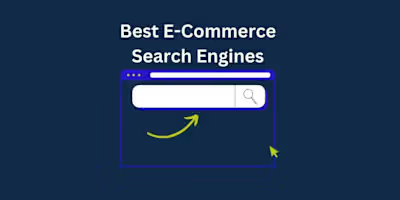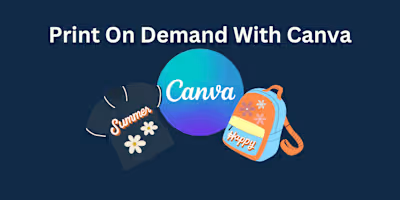How to Start a Print-on-Demand Business on Etsy In 6 Easy Steps
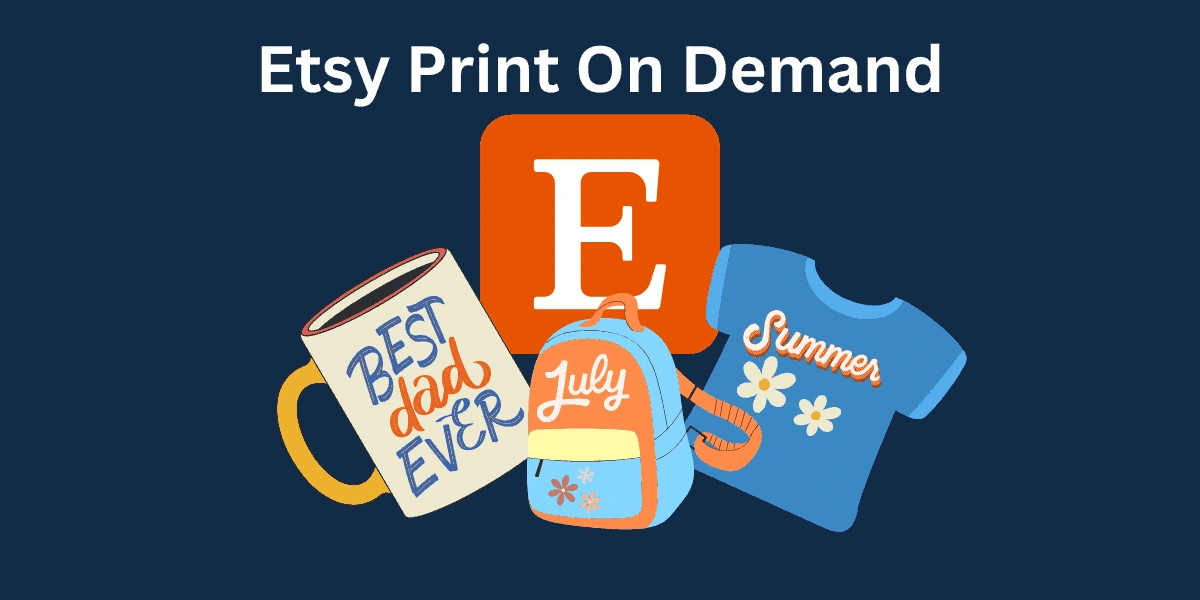
So you’re chilling at home, coffee in hand, fantasizing about being your own boss. But then reality slaps you in the face—startup costs, inventory, and the fear of stuff not selling. We’ve all been there, right?
Here’s where Print on Demand and Etsy come to the rescue. This duo is like the peanut butter and jelly of the business world. You list your designs on Etsy, and they only get printed when someone hits “buy.” No upfront costs, no dusty inventory. Plus, everyone shopping on Etsy already loves custom products.
And the best part? Getting started is a breeze. Seriously, all you gotta do is create your Etsy and Print on Demand accounts, link ’em up, create some cool designs, slap ’em on products, and boom—you’re in business.
So why’s this combo a winner? It lets you dip your toes into entrepreneurship without diving headfirst into debt. You get to flex your creative muscles while Etsy and your Print on Demand service handle the nitty-gritty.
Ready to make that daydream your 9-to-5? Stick around, and I’ll break down how to start a print-on-demand business on Etsy in this simple step-by-step guide.
How to Start a Print-on-Demand Business on Etsy: Step By Step
Starting a Print on Demand (POD) business on Etsy may seem like a daunting task, but with some determination and guidance, you’ll be up and running in no time.
Quick Overview Of The Steps
Find Your Niche: To start you’ll need to identify a specific market you want to target. This should be based on your personal interests, trending topics, and or a gap in the market.
Setting Up Your Etsy Account: You need to set up your Etsy seller account. This is the face of your business, so choose an Etsy shop name that reflects your brand and resonates with your target audience.
Creating Your Designs: Once you’ve identified your niche, start creating unique designs that will appeal to your target audience. You can create these designs yourself, hire a designer, or use design tools.
Choosing Your Print-on-Demand Supplier: A good production partner is key to your business’s success. Consider factors such as product range, print quality, pricing, and shipping options when making your decision.
Listing Your Products on Your Etsy Shop: Once your designs are ready, it’s time to list your products on your Etsy shops. You’ll need to include detailed descriptions and high-quality images on your Etsy listing to attract customers.
Marketing Your Etsy Store: Now that your Etsy shop is up and running, it’s time to bring the customers. Use social media, SEO, and other marketing strategies to drive traffic to your Etsy store. Remember, the more visibility your shop has, the more sales you’re likely to make.
Remember, starting a Print on Demand business on Etsy is a journey, not a destination. It will take time and effort, but with persistence and the right strategies, you can build a successful Etsy business.
1. Finding Your Niche

First up, it’s time to choose your niche. A niche is a specific segment of the market that you plan to target with your products. Your niches will encompass all of the print-on-demand products you will be selling and what will be on them.
When selecting a niche, consider the following:
– Your Interests and Passions: Choose a niche that you’re genuinely interested in. This will make it easier for you to create designs and market your products. Plus, customers can often tell when a business owner is passionate about what they’re selling, and it can make your brand more appealing.
For example, if love jewelry, consider opening a custom jewelry store, but if you’ve never worn jewelry in your life it probably wouldn’t fit too well. Pick something you know and love.
– Market Demand: Check the marketplace to see what other sellers are selling that you’re considering. See what products they have and what you think is missing to determine if there’s a place for you in the market. If you see a market that is extremely overloaded (like cat tees), maybe you should look for something different.
– Profit Potential: Some niches may be more profitable than others. Consider what prices people will pay for your products and the potential size of your customer base.
Remember, finding the right niche is a balance between choosing something you’re passionate about and something that has market demand. It might take some time and research, but finding your target market is a crucial step in setting up a successful POD Business.
If you’re still not sure about your niche, read about some of the top print-on-demand niche ideas.
With your niche selected, we can move on to creating your Etsy storefront.
2. Setting Up Your Etsy Account
Setting up your account is like setting up your very own digital storefront. It’s the first impression customers will have of your brand, so you want to make it count. Before we start, head over to Etsy’s sellers page to begin the process.
Steps To Create Your Etsy Account
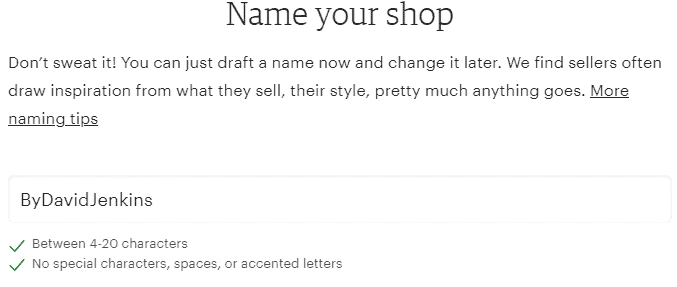
1. Choose a Shop Name: This is the name that customers will see when they visit your Etsy shop. It should be unique, memorable, and reflect the essence of your brand.
Try not to overthink your shop name as you can come back and change it if you’d like.
2. Fill Out Your Shop Preferences: This includes selecting your shop language, country, and currency. These preferences help Etsy personalize your shop experience.
3. Stock Your Shop: This is where you’ll add the products you want to sell. For now, just add a placeholder listing to create your account. We’ll come back to this after you create your first designs.
4. Choose How You’ll Get Paid: Etsy offers multiple payout options for getting paid. They also have Etsy Payments, which allows you to accept multiple forms of payment such as credit cards, debit cards, Etsy Gift Cards, and more.
5. Set Up Billing: This is where you’ll provide a valid credit card for any selling fees you may incur. Etsy fees include a listing fee($0.20) and transaction fee(6.5%).
6. Open Your Shop: Once you’ve completed all the steps, you can open your Etsy shop to the public. It’s a bit like cutting the ribbon at a store opening but in the digital world!
Remember, your account is the foundation of your Etsy business. Take the time to set it up properly, and you’ll be well on your way to running a successful print-on-demand business on Etsy.
3. Creating Your Designs
Creating designs for your shop is where your creativity gets to shine. It’s like painting a canvas, but instead of paint, you’re using your ideas and imagination.
Understand Your Niche
Before you start designing, make sure you fully understand your audience. What are their interests? What kind of designs do they like? This will help you create designs that resonate with your customers.
Create Unique Designs:
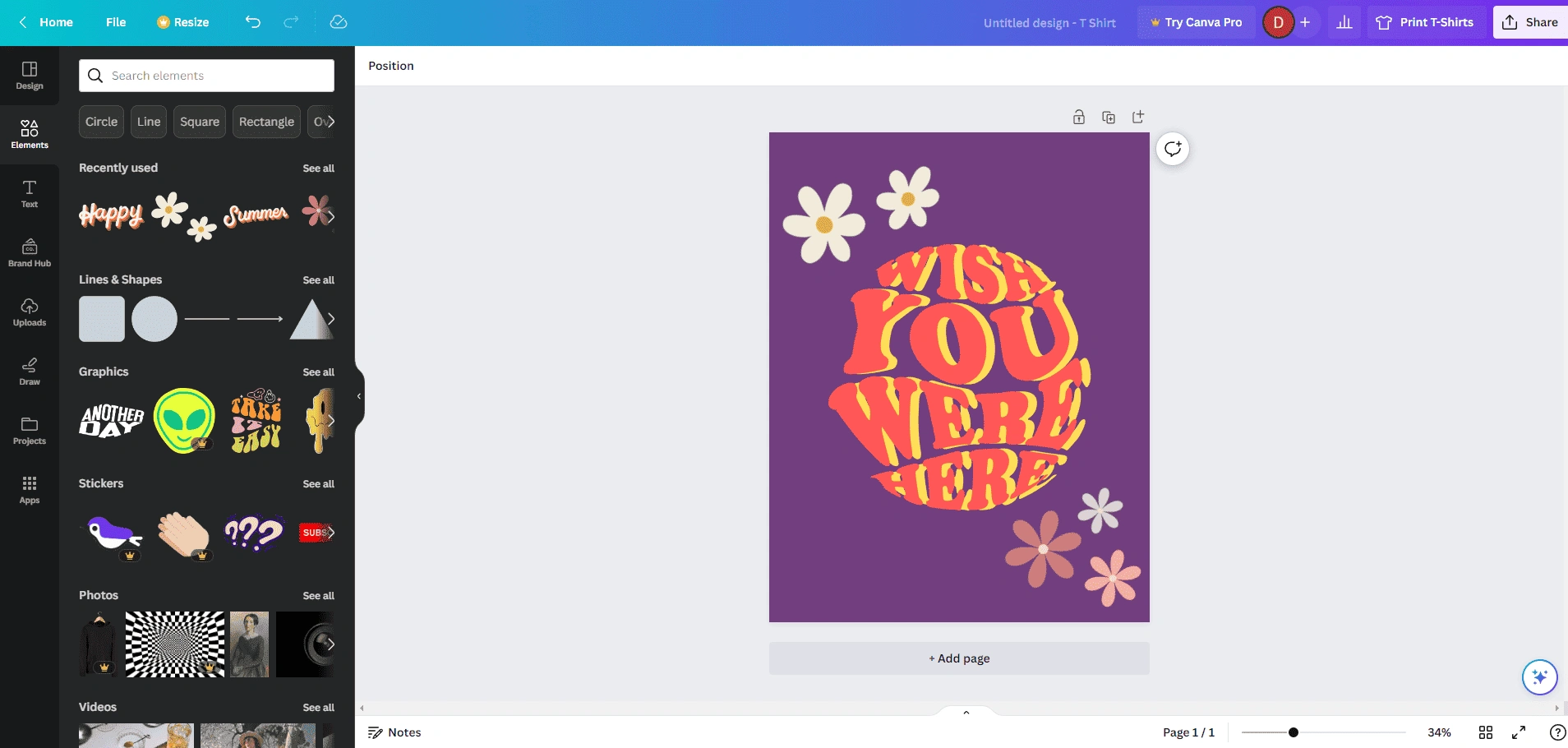
I recommend creating your own designs in the beginning as it’s a great way to be involved in creating your brand image and it keeps costs low.
You can use graphic design tools such as Adobe Illustrator if you’ve got the skills. However, if you’re new to this, it’s simple to use a tool like Canva online for free to create some pretty nifty designs.
You could also use pre-made design templates available on platforms like Canva as a starting point for your designs. Just be sure to customize them to fit your own brand.
If you’re not comfortable creating your own designs, you can hire freelance graphic designers from platforms like Upwork or Fiverr. But be strategic when doing this as it will eat into your profit margin.
Remember, your designs are the heart of your Etsy print-on-demand store. So make sure Etsy shoppers love what they see.
Now, let’s move on to choosing your new production partner.
4. Choosing Your Print-on-Demand Supplier

My personal favorite print supplier, Printful
The right Print-on-demand supplier for your Etsy shop is like choosing a dance partner. You want someone reliable, who can keep up with you, and who won’t step on your toes! So, how do you find that perfect fit?
Product Range: Does the service offer the types of products you want to sell? This could include t-shirts, hoodies, mugs, posters, and more.
Print Quality: Look for reviews or order samples to assess the print quality. Your designs should look vibrant and sharp on the products.
Pricing: Compare the pricing of different services. Remember, the cost of printing and shipping will be deducted from your selling price, so it’s important to find a service that offers competitive pricing.
Shipping: Consider the shipping options the service offers. How long does it take for products to be delivered? Do they offer tracking? Can they ship internationally? How much does it cost?
Integration: Make sure your chosen service integrates with Etsy. This is what makes this business run smoothly.
If you want somewhere to start we recommend Printful or Printify. They are the best print providers in the industry, offering the best consistent quality and service while also having a wide range of products. On top of that they are extremely beginner-friendly.
Choosing the right supplier for your Etsy store can make all the difference so it’s worth taking the time to do your research.
Now that you’ve got your designs and supplier, it’s time to make some listings to show off your products.
5. Listing Your Products
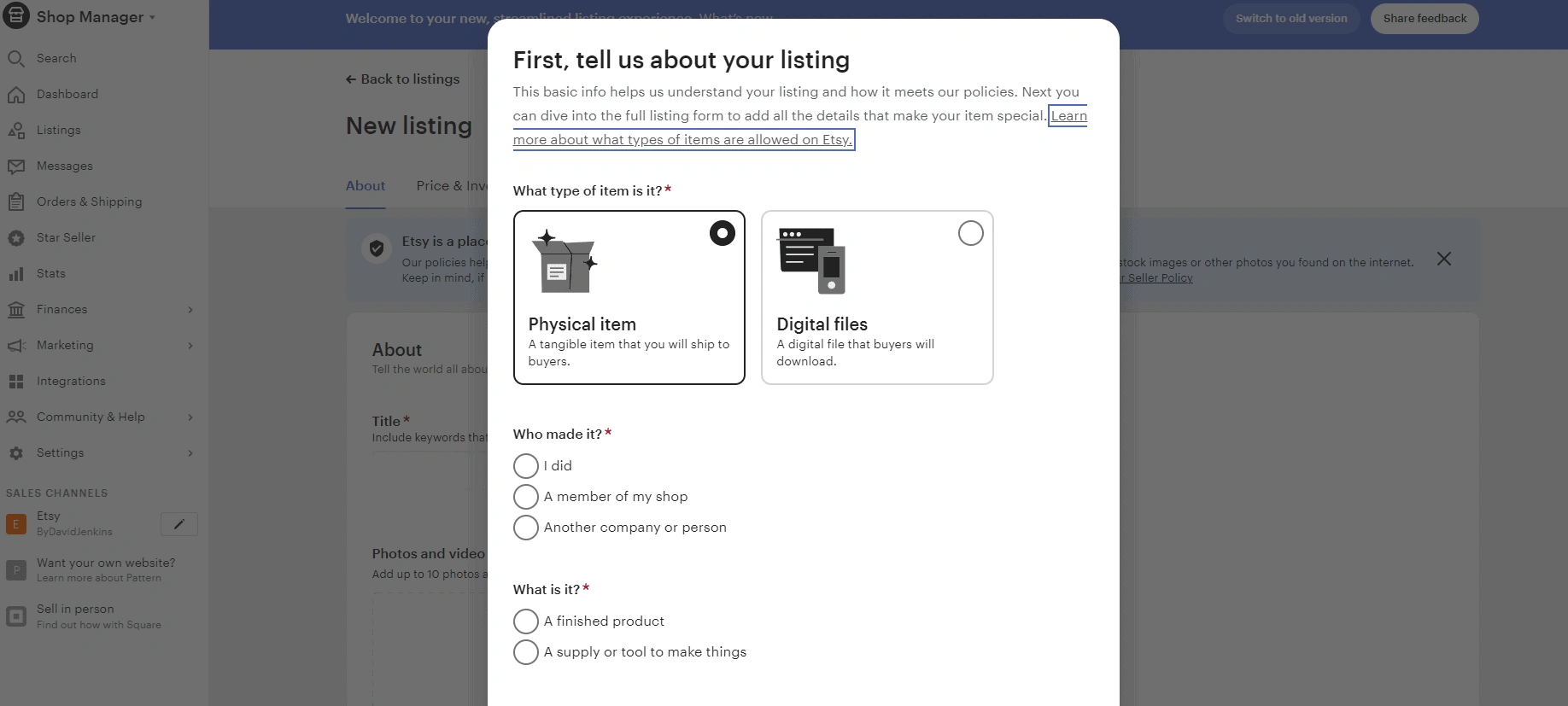
Your Etsy Listings are the display window for your store. It’s what attracts customers and entices them to come in and explore further. This will be your first impression for most customers, so make it count.
Product Titles and Descriptions:
Make sure your product titles and descriptions are clear, descriptive, and engaging. They should accurately represent your product and include relevant Etsy SEO keywords to help your products show up in Etsy search results.
Quality Images
Images are arguably the most important part of your product listing. They should be high-quality, well-lit, and showcase your product from various angles. If possible, include images of your product being used in real-life situations.
A good print-on-demand partner will have a mockup generator for your products, which makes high-quality images a breeze.

Pricing Your Products
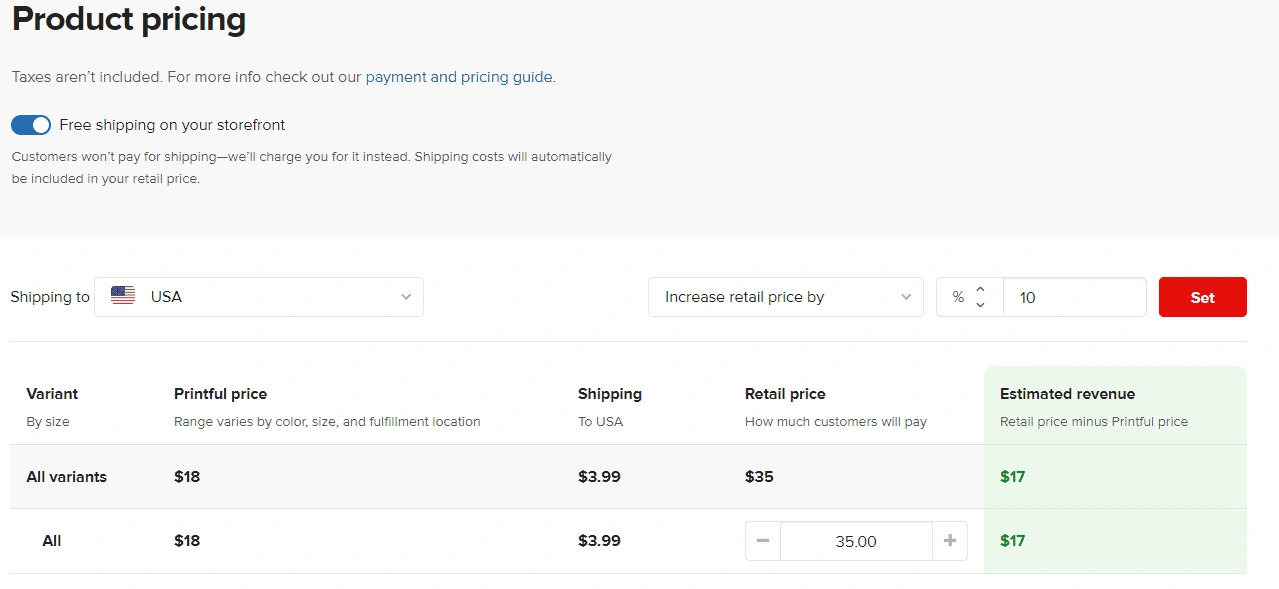
Prices from Printful’s listing creator
Look at the competition and see how your products compare in quality. Are you offering embroidery and they’re not? Are your designs higher quality? These are good reasons to raise your prices over the competitor, just be sure to tell the customers why yours is better.
You also need to take into factor the shipping costs, Etsy fees, and any marketing you may have done into these prices.
Taking all of this into consideration when setting your prices will ensure you get the profits you are expecting with no unexpected surprises.
Shipping
Similarly to you wanting to know how much you’re making, the customers want to see how much they’re paying for what. Be sure to clearly state your shipping policies, including costs, shipping methods, and estimated delivery times. Transparency is key.
Tags and Categories
Lastly, use relevant tags and categories to help customers find your products. Think about what terms customers might use to search for your products and use those as tags.
Remember, your product listings are often the first interaction customers have with your Etsy store. Make a good first impression, and you’ll be well on your way to making sales.
6. Marketing Your Etsy Store
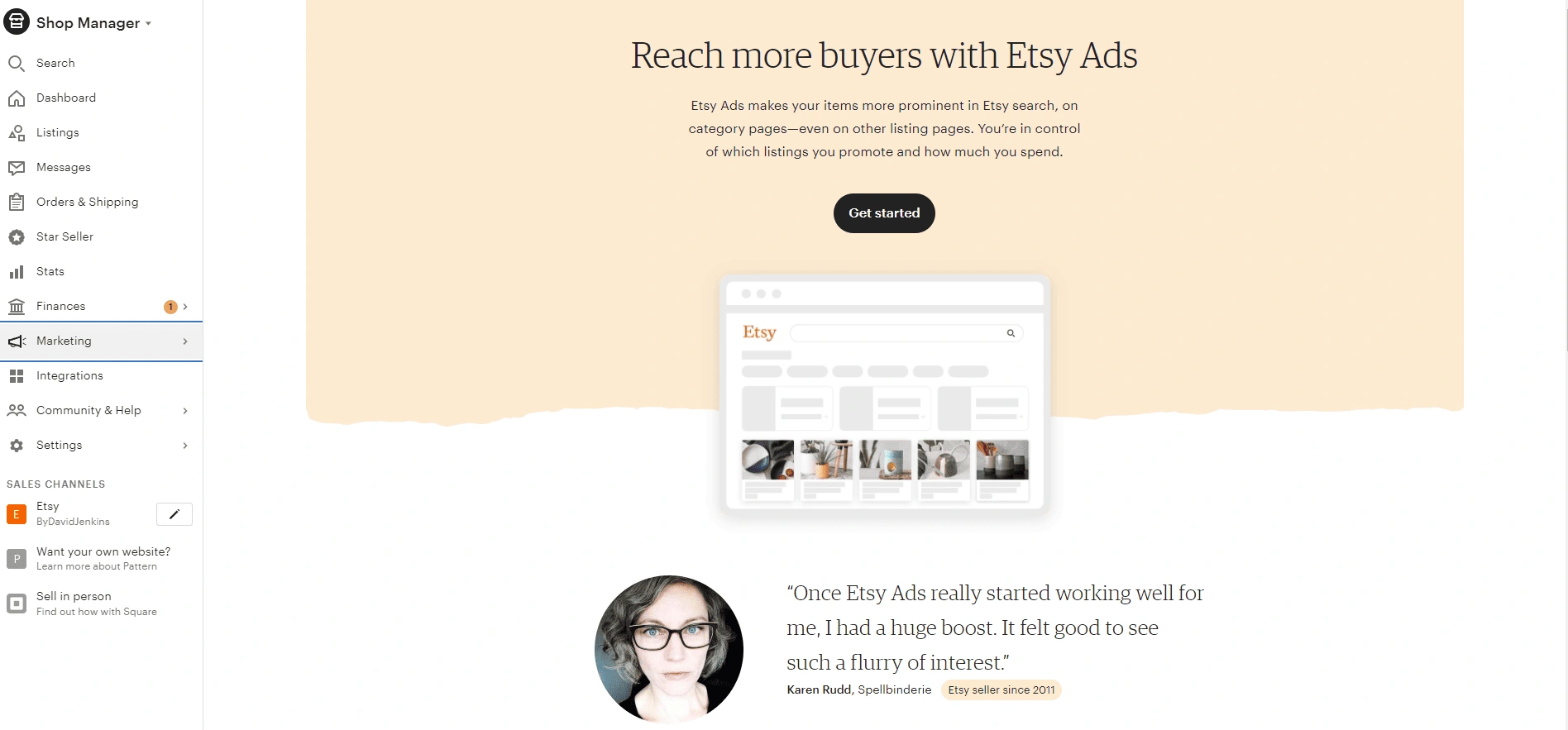
Marketing your Etsy store is like hosting a party. You’ve set everything up, and now it’s time to invite people in! So let’s dive into the ways you can drive people to your products.
SEO: Etsy has its own search engine, so understanding how to optimize your listings for Etsy’s search engine can help increase your shop’s visibility. This includes using relevant keywords in your product titles, descriptions, and tags.
Social Media: Social media platforms like Instagram, Pinterest, and Facebook can be powerful tools for promoting your shop. Share your products, behind-the-scenes peeks into your design process, and engage with your followers. I’ve found that customers love getting to know the person behind the shop!
Email Marketing: Building an email list can be a great way to keep your customers informed about new products, sales, and more. It’s like having a direct line to your customers.
Paid Advertising: Consider using paid advertising to reach a larger audience. Etsy offers its own advertising platform, but you can also use Google Ads or social media advertising.
Collaborations: Collaborate with other Etsy sellers or influencers in your niche. This can help you reach a larger audience and bring new customers to your shop.
Remember, marketing is all about reaching your target audience and letting them know what you have to offer. It takes time and effort, but the results can be well worth it. Now, let’s jump into some key considerations for starting your business.
Key Considerations For Successfully Starting a Print-on-Demand Business on Etsy
Starting a print-on-demand business on Etsy is an exciting journey, but like any journey, it’s important to be prepared.
Understand Your Market
Before you dive into the world of print-on-demand products, take some time to understand your market. Who are your potential customers? What are they looking for? What kind of designs do they like? The more you understand your market, the better you can cater to their needs.
Quality Over Quantity
It can be tempting to flood your shop with a multitude of designs, but remember, quality trumps quantity almost every time. It’s better to have a handful of exceptional designs that resonate with your audience than a plethora of mediocre ones.
Stay Up-to-Date
Trends change, and what’s popular today might not be popular tomorrow. Keep an eye on current trends and be ready to adapt your designs and products accordingly. This will help keep your Etsy shop fresh and relevant.
Patience is Key
Building a successful Etsy store doesn’t happen overnight. It takes time, effort, and a lot of patience. But don’t be discouraged. Keep pushing forward, learn from your mistakes, and celebrate your victories, no matter how small.
Remember, every shop is unique, and what works for one may not work for another. Don’t be afraid to experiment, take risks, and carve your own path. After all, that’s what entrepreneurship is all about!
How to Scale Your Print-on-Demand Business
Once you’ve established your shop and are seeing consistent sales, it’s time to think about scaling your print-on-demand business. We’ve got a few tips to help take your POD Etsy store to the next level.
1. Expand Your Product Range: One of the simplest ways to grow your business is to expand your product range. If you’ve been selling t-shirts, consider adding other products like mugs, posters, or tote bags. This not only attracts new customers but also gives existing customers more options to choose from.
2. Optimize Your Listings: Use Etsy’s analytics to understand which of your products are performing well and which aren’t. Use this information to optimize your listings, improve your designs, and increase your sales.
3. Invest in Marketing: As your business grows, consider investing more in marketing. This could mean using paid advertising, hiring a social media manager, or even collaborating with influencers in your niche.
4. Provide Exceptional Customer Service: Never underestimate the power of exceptional customer service. Happy customers are more likely to become repeat customers and recommend your shop to others.
5. Consider Outsourcing: As your business grows, you might find yourself overwhelmed with tasks. Consider outsourcing tasks like design work or customer service to free up your time and focus on growing your business.
Remember, scaling a business is a marathon, not a sprint. Take your time, make strategic decisions, and before you know it, you’ll see your Etsy shop grow and thrive. Now that you know how to get your business running and how to grow to the moon, let’s take a look at what print-on-demand really is.
What is a Print-on-Demand?
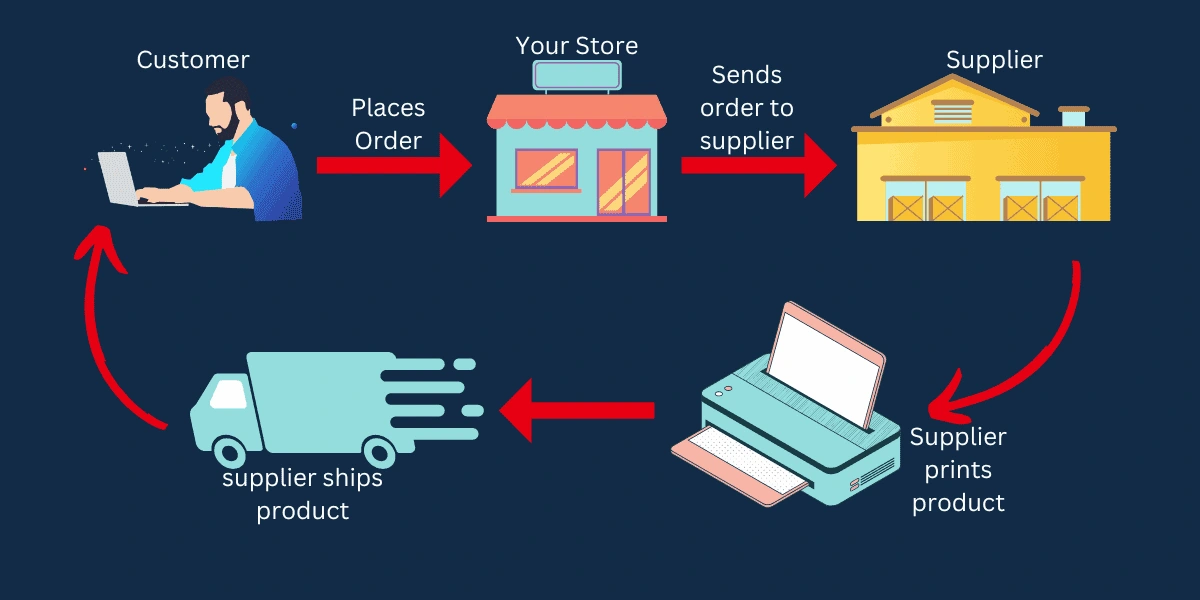
It’s an e-commerce business model that lets you sell your own custom-designed products without needing to keep any inventory or have upfront costs.
It’s one of the best ways to make money online, especially for new entrepreneurs.
Instead of the traditional retail grind where you buy a bunch of products upfront and hope they sell, print-on-demand is way cooler. You create a design, upload it to a platform offering print-on-demand services, and list it for sale on your store.
When someone buys it, the order goes to the print-on-demand provider. They print your design, package it, and ship it straight to the customer. You only pay after a sale has been made, slashing the risk and upfront cash.
It’s a hit for selling custom stuff like apparel, home decor, and accessories.
You get to be creative, try out different designs, and build a brand without needing a pile of money or dealing with inventory and shipping headaches.
Why You Should Start A Print On Demand Business
Low Upfront Investment: Unlike traditional retail businesses that require you to buy and hold inventory, print-on-demand only requires you to pay for the product after a customer has made a purchase. This significantly reduces the financial risk and makes it a viable option for entrepreneurs on a budget.
Flexibility and Creativity: With print on demand, you have the freedom to create and sell a wide variety of custom products featuring your unique designs. This allows you to express your creativity and build a brand that truly represents your vision.
Scalability: As your business grows, your POD service provider can easily handle increased order volumes. This means you can focus on expanding your business without worrying about operational logistics.
No Inventory Management: Since print-on-demand products are only created after a sale is made, you don’t have to worry about managing inventory or finding storage space.
Global Reach: With an online store, you can reach customers from all over the world. Many print-on-demand service providers also offer worldwide shipping, making it easy for you to sell your products internationally.
Why You Should Use Etsy For Your Print On Demand Business
Easy Peasy Start: Unlike other platforms that make you jump through hoops, Etsy is super user-friendly. You set up your shop, link it to your Print on Demand account, and you’re good to go. Perfect for those who don’t wanna mess around with complicated setups.
Built-In Audience: Etsy’s already got a massive crowd that’s hungry for unique, custom stuff. So, you’re not shouting into the void; you’re stepping onto a stage with an audience that’s ready to buy. That’s like starting a band and already having fans!
Trust Factor: People trust Etsy. It’s been around, and it’s got a rep for quality and customer service. When you set up shop there, you’re borrowing some of that trust, which can be a huge leg up when you’re just starting.
SEO Juice: Etsy’s got some solid search engine optimization (SEO) game. That means your products have a better shot at showing up in Google searches, which is basically free advertising. Who doesn’t want that?
Global Game: Just like with most Print on Demand services, Etsy lets you sell to folks all around the world. They even handle currency conversions and international payments for you. So you can go global without breaking a sweat.
Alternatives to Etsy
1. Shopify: This platform gives you total control over your online store. You can customize it to your heart’s content and even get into the nitty-gritty of SEO. It’s a bit more hands-on but offers more freedom than Etsy.
2. Amazon Merch: If you want to sell products to a massive customer base, Amazon’s got you covered. The catch? It’s super competitive, and Amazon takes a good chunk of your profits. But hey, you’re swimming in a big pond.
3. Redbubble: This one’s great for artists. You upload your designs, and Redbubble puts them on everything from t-shirts to phone cases. It’s less about the products and more about showcasing your art.
4. Teespring: Similar to Redbubble but with a focus on apparel. You can create custom clothing lines without worrying about production or shipping. Plus, they’ve got some cool marketing tools to help you get the word out.
5. WooCommerce: If you’ve got a WordPress site, WooCommerce is a plugin that turns it into an online store. It’s a bit more DIY, but you get to keep more of your profits.
Remember, the best platform for you depends on what you’re looking to get out of your Print on Demand business. Want total control? Shopify or WooCommerce might be your jam. Looking to focus on art? Redbubble’s where it’s at.
Wrapping Up and My Experience With Starting a Print-on-Demand Business on Etsy
Jumping into the Print on Demand (POD) world isn’t just a side gig; it’s a real-deal business model. And when you pair it with a platform like Etsy, you’re setting yourself up for success. Trust me, with a background in e-commerce and tons of research under my belt, I think it’s a great opportunity.
Understanding your target audience is key. You gotta know what they’re into so you can create designs they’ll actually wanna buy. And don’t think you can just set it and forget it—market research is an ongoing gig to keep you ahead of the curve.
Customer service? Huge. Even if you’re not face-to-face, how you handle issues online can set you apart from the competition. Quick and efficient problem-solving is your secret weapon here.
Look, POD isn’t a get-rich-quick scheme. It’s a blend of creativity, strategy, and good old-fashioned grit. But if you’re willing to put in the work, especially on a trusted platform like Etsy, it’s a legit way to satisfy both your creative itch and your wallet.
So if you’re eyeing POD, you’re already on the right path. It’s a solid move for those ready to roll up their sleeves.
Like this project
Posted Sep 8, 2023
Discover how to start a print-on-demand business on Etsy with our detailed 7-step guide. Turn your creative ideas into a successful Etsy shop today!
Likes
0
Views
47





